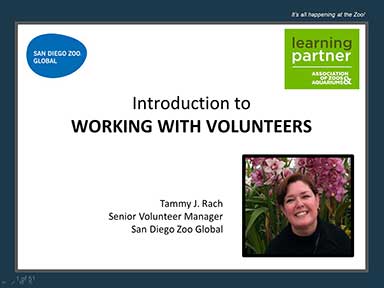 |
Anger Management |
1.00 |
Anger is a set of physical responses, emotions, and behaviors triggered by a perceived threat or frustration. Anger can be harmful or helpful, depending on how you cope with your anger and the anger of others. This course will explore how to understand your anger better and manage your anger responses. You'll also examine the causes of anger and ways to use it constructively. |
 |
An Introduction to Working with Volunteers |
1.00 |
1/12/23 jg unchecked forward seek and shut off CEUs - Volunteers are an integral part of our organizations and their engagement is critical to our success. So what does it take to successfully work with volunteers? This webinar, hosted by Tammy Rach, Senior Volunteer Manager for San Diego Zoo Global, will take you through: who volunteers are, what they want, and how to best engage them in the ultimate mission fulfillment. Participants will also receive a copy of this presentation to share with staff so they can start building their own Volunteer Tool Kit. |
 |
Americans With Disabilities Act and Transition Plans |
1.00 |
Do Title II and Title III of the Americans with Disabilities Act apply to you?
Do you work for a non-profit or for-profit zoo, aquarium, or museum? Is your zoo, aquarium, or museum operated by your state or local government? Do you have a Transition Plan or Barrier Removal Plan for your organization? Do you know that the Justice Department or your State's Attorney's Office could sue your organization if you are not in compliance? Fines can cost an organization $55,000 plus compensation just for an initial infraction.
This comprehensive webinar will discuss the development of a plan, examples of that plan, common accessibility issues, and an overview of what to look for in your policies and procedures that could cause an accessibility issue. |
 |
ALS Airway Response - Part Two |
1.00 |
In a twenty minute discussion, Dr. Galton shared some very valuable opinions that were formulated, in a large part, from his many years as a paramedic. Join us for an extension of this discussion. In this second part, Dr. Galton briefly discusses exhalation of CO2, Instrumenting an Airway, Management of Gastric Tubes, and more. You have two attempts to gain a 70% or higher on this exam. Take your time and good luck! |
 |
ALS Airway Response - Part Three |
0.75 |
This final session offers some thoughts on what should be accomplished when attempting to intubate the sickest of patients. This is a brief overview that allows the new ALS provider a chance see what should be learned. Think of this as an opportunity to learn how to assist RSI technicians with what they do.This is a very challenging exam, please take your time. You have two attempts to gain a 70% or higher. Good luck! |
 |
ALS Airway Response - Part One |
1.00 |
This conversation with Dr. Christopher Galton turns into a lesson that any paramedic (no matter what their background) will find beneficial in their attempt(s) to improve their Airway Skills. Dr. Galton, leads this discussion by bringing together his experiences in the pre-hospital arena, the emergency department, the ICU, the operating room, and beyond. Pull out a pen and paper and get ready to write down talking points that you will undoubtedly debate with fellow paramedics. You have two attempts to gain a 70% or higher on the exam. Take your time and good luck! |
 |
AI in Education: Crafting Effective Policies for Educators and Administrators |
1.00 |
This course covers crafting effective artificial intelligence policies for educators and administrators. It is just one out of many K-12 educator courses we offer. This course will help you develop new knowledge about the benefits of utilizing artificial intelligence while upholding the principles of ethics, equity, and data privacy. Educators and administrators will be able to navigate the fundamentals of artificial intelligence and create robust policies that ensure responsible and inclusive artificial intelligence adoption, ultimately enhancing student learning outcomes. |
 |
After School Improvement Series: Outdoor Environments |
0.50 |
The After School Improvement Series: Outdoor Environments course will:
Describe different types of outdoor environments, along with the opportunities and challenges each one offers.
Discuss the role outdoor environments play in encouraging children to be active, while promoting a range of different experiences.
Identify the steps you can take to ensure that the outdoor environment is safe and accessible for all children.
Explore how outdoor environments can be used to extend learning opportunities found in indoor environments.
|
 |
After School Improvement Series: Indoor Environments |
0.50 |
This webinar will discuss the role a well-planned indoor environment plays in supporting the developmental needs of school-age children. It will talk about the use of interest areas as tools for creating an indoor environment that supports children’s interests and developmental needs. In addition, we’ll learn how to plan indoor environments that are warm and inviting, help children feel welcome and comfortable and will allow them to participate in different activity areas at the same time without disturbing one another. And finally, we’ll discuss the role a well-planned indoor environment plays in keeping children safe and engaged. |
 |
After School Improvement Series: Emergency Action Plans |
0.50 |
Like all other early childhood and school-age settings, after school programs need to consider how they prepare for and respond to emergency situations, from natural disasters, like storms, earthquakes, tornados, flash floods, or volcanic eruptions; fires; power outages; missing children; or acts of violence, including active shooter situations. Some emergency situations may require evacuation, while others may initiate a lock down, or shelter-in-place. The best way to prepare for emergency situations is to plan for them. We can do this by considering the kinds of emergency situations we might encounter, and then developing a series of procedures and protocols for responding to them. Your program’s Emergency Action Plan sets out your role and responsibilities should any of these emergencies occur.
|
 |
African Penguins |
1.00 |
This course presents historical and current threats to this endangered species, along with what is being done to help save them. Dive into their wet and wild world and discover details of how these birds behave. |
 |
Affordable Care Act (ACA) Basics for Business Owners (Corrections) |
0.34 |
This course covers how the Affordable Care Act (ACA) affects small business owners in terms of what standards and regulations they need to know.
This course will also cover reporting requirements for business owners and the responsibilities of the employer mandate. |
 |
Affordable Care Act (ACA) Basics for Business Owners |
0.34 |
This course covers how the Affordable Care Act (ACA) affects small business owners in terms of what standards and regulations they need to know.
This course will also cover reporting requirements for business owners and the responsibilities of the employer mandate. |
 |
Advocating for Early Childhood Care (CDA 6) |
2.00 |
This course equips you with the tools and knowledge to become a powerful advocate in the early childhood system. Explore various advocacy roles, tap into a wealth of resources, and dive deep into your responsibilities as an advocate. Prepare to take action, make your voice heard, and be a transformative force for young learners. |
 |
Advanced Interpersonal Communication: Supervisors (Instructor Guide) |
0.75 |
When you think of a supervisor, you probably think of your immediate boss. However, in the workplace, most people have several supervisors. Your workplace might be divided into teams, departments or divisions. Within each level, there is a supervisor to whom you are accountable, even if you do not deal with that person on a day-to-day basis. Company executives and board members can also be considered supervisors because they might have the power to make decisions regarding your employment, salary, promotions, and work assignments. It is important to communicate effectively with all of your supervisors to maintain an efficient workplace and to be able to promote your own ideas for improvements.
In this course you will learn to: identify the types of ineffective supervisors and ways to interact with them, and negotiate a raise with a supervisor and offer an effective resignation.
This Instructor's Edition of this course includes notes and suggestions to assist you in presenting the material, whether in an in-person classroom setting or as an instructor-led online or distance-learning course. It also provides you with the answers to questions found in mid-lesson activities, as well as in the quiz that concludes the course. |
 |
Advanced Interpersonal Communication: Supervisors |
0.75 |
When you think of a supervisor, you probably think of your immediate boss. However, in the workplace, most people have several supervisors. Your workplace might be divided into teams, departments or divisions. Within each level, there is a supervisor to whom you are accountable, even if you do not deal with that person on a day-to-day basis. Company executives and board members can also be considered supervisors because they might have the power to make decisions regarding your employment, salary, promotions, and work assignments. It is important to communicate effectively with all of your supervisors to maintain an efficient workplace and to be able to promote your own ideas for improvements.
In this course you will learn to: identify the types of ineffective supervisors and ways to interact with them, and negotiate a raise with a supervisor and offer an effective resignation. |
 |
Advanced Interpersonal Communication: Organizational Culture (Instructor Guide) |
1.34 |
An organizational culture is the personality of an organization. This personality is both determined and accepted by the organization’s members. For example, an organization might have a culture that is youthful, energetic, and fast-paced. In this type of culture, decisions are made quickly, and employees are empowered to take action in a wide variety of situations. Another organization might be more straight-laced and policy-oriented. This organization would be much more formal and serious in the way it does business. It is important to recognize and understand the culture of an organization, so that you can determine your fit with the organization.
In this course you will learn: to determine the nature of an organization’s culture, to use the cultural network to your advantage, and identify the characteristics of the roles exhibited in the network, to identify the elements of physical culture that affect interpersonal communication, and to identify the ways in which managers can build a positive culture.
This Instructor's Edition of this course includes notes and suggestions to assist you in presenting the material, whether in an in-person classroom setting or as an instructor-led online or distance-learning course. It also provides you with the answers to questions found in mid-lesson activities, as well as in the quiz that concludes the course. |
 |
Advanced Interpersonal Communication: Organizational Culture |
1.34 |
An organizational culture is the personality of an organization. This personality is both determined and accepted by the organization’s members. For example, an organization might have a culture that is youthful, energetic, and fast-paced. In this type of culture, decisions are made quickly, and employees are empowered to take action in a wide variety of situations. Another organization might be more straight-laced and policy-oriented. This organization would be much more formal and serious in the way it does business. It is important to recognize and understand the culture of an organization, so that you can determine your fit with the organization.
In this course you will learn: to determine the nature of an organization’s culture, to use the cultural network to your advantage, and identify the characteristics of the roles exhibited in the network, to identify the elements of physical culture that affect interpersonal communication, and to identify the ways in which managers can build a positive culture. |
 |
Advanced Interpersonal Communication: First Impressions and Building Rapport (Instructor Guide) |
0.67 |
Although it only takes 30 to 45 seconds to formulate a first impression, it often requires four or five additional encounters to change someone's first impression. Many times, once you've made a first impression, you will not have a second opportunity to change that impression. Therefore, it's important to make your best impression on the first try.
In this course you will learn: to identify the elements that influence a first impression, to build rapport, and establish credibility with others, and to build positive relationships.
This Instructor's Edition of this course includes notes and suggestions to assist you in presenting the material, whether in an in-person classroom setting or as an instructor-led online or distance-learning course. It also provides you with the answers to questions found in mid-lesson activities, as well as in the quiz that concludes the course. |
 |
Advanced Interpersonal Communication: First Impressions and Building Rapport |
0.67 |
Although it only takes 30 to 45 seconds to formulate a first impression, it often requires four or five additional encounters to change someone's first impression. Many times, once you've made a first impression, you will not have a second opportunity to change that impression. Therefore, it's important to make your best impression on the first try.
In this course you will learn: to identify the elements that influence a first impression, to build rapport, and establish credibility with others, and to build positive relationships. |
 |
Advanced Interpersonal Communication: Customers and Vendors (Instructor Guide) |
0.50 |
Your customers include anyone who uses your company or organization to obtain goods and services. Customers might be internal or external. An internal customer is a member of your organization and can be a supervisor, colleague, or subordinate. An external customer is someone from outside your organization. Each customer is of equal importance, regardless of the amount of business that customer provides to your organization. You should provide the same level of quality goods and services all your customers, and all are equally deserving of efficient and effective communication.
In this course you will learn: to respond to customers’ complaints, and to reject a vendor’s contract without rejecting the vendor, and address a complaint to a vendor.
This Instructor's Edition of this course includes notes and suggestions to assist you in presenting the material, whether in an in-person classroom setting or as an instructor-led online or distance-learning course. It also provides you with the answers to questions found in mid-lesson activities, as well as in the quiz that concludes the course. |
 |
Advanced Interpersonal Communication: Customers and Vendors |
0.50 |
Your customers include anyone who uses your company or organization to obtain goods and services. Customers might be internal or external. An internal customer is a member of your organization and can be a supervisor, colleague, or subordinate. An external customer is someone from outside your organization. Each customer is of equal importance, regardless of the amount of business that customer provides to your organization. You should provide the same level of quality goods and services all your customers, and all are equally deserving of efficient and effective communication.
In this course you will learn: to respond to customers’ complaints, and to reject a vendor’s contract without rejecting the vendor, and address a complaint to a vendor. |
 |
Advanced Interpersonal Communication: Communication Styles and Methods (Instructor Guide) |
0.75 |
To be successful in the workplace, you must be able to effectively communicate and cooperate with clients and co-workers. Learning about the four types of communication styles helps a listener understand a speaker’s perspective. It also helps a speaker understand how their communication affects the listener.
In this course you will learn: to identify primary and secondary communication styles, and to communicate using various verbal and nonverbal modes of communication.
This Instructor's Edition of this course includes notes and suggestions to assist you in presenting the material, whether in an in-person classroom setting or as an instructor-led online or distance-learning course. It also provides you with the answers to questions found in mid-lesson activities, as well as in the quiz that concludes the course. |
 |
Advanced Interpersonal Communication: Communication Styles and Methods |
0.75 |
To be successful in the workplace, you must be able to effectively communicate and cooperate with clients and co-workers. Learning about the four types of communication styles helps a listener understand a speaker’s perspective. It also helps a speaker understand how their communication affects the listener.
In this course you will learn: to identify primary and secondary communication styles, and to communicate using various verbal and nonverbal modes of communication. |
 |
Advanced Interpersonal Communication: Colleagues and Subordinates (Instructor Guide) |
0.50 |
Colleagues might include people in your office, team, department, or division. They do not hold a supervisory position over you, nor do you hold a supervisory position over them. Instead, you are all in a similar place on the corporate ladder. Learning how to communicate effectively with your colleagues helps maintain a friendly and effective workplace, and enables you to better promote your ideas and respond to those of others.
In this course you will learn: to identify the guidelines for communicating with colleagues, and how to take appropriate steps to apologize to subordinates; use appropriate tactics to refuse a subordinate’s request; and dismiss a subordinate.
This Instructor's Edition of this course includes notes and suggestions to assist you in presenting the material, whether in an in-person classroom setting or as an instructor-led online or distance-learning course. It also provides you with the answers to questions found in mid-lesson activities, as well as in the quiz that concludes the course. |


























